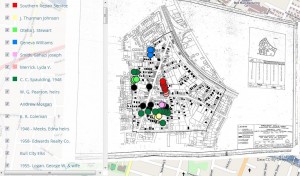We are working on four beta pilot projects to field test DH Press. Using Robert Allen’s AMST 840: Digital Humanities/Digital American Studies graduate seminar as the test bed, we have devised four unique projects in collaboration with various “clients” (or partners) across the university, the state, and the globe. The ten or so graduate students working in teams with these clients represent a range of disciplines: Information/Library Science, Education, Geography, Religious Studies, and History. These projects will launch by the beginning of May, though some of them will be proof of concepts, and others will be part of larger projects that the DIL will continue working on after the end of the semester.
Field-Based Learning Project
Field-Based Learning Project
This project explores the potential uses of digital tools in two Honors Study Abroad and Burch Field Research Seminars: Chris Teuton’s Burch Field Research Seminar: Cherokee History, Language, and Culture (postponed) and Lucia Binotti’s Honors Program in Rome (Summer 2013). Building on a growing body of research focused on immersive learning environments, often through games and avatar simulations, this project will visualize the learning process for “in the field” contexts. The DH Press project will extend and enrich the learning environment, connecting the physical places the students encounter with the digital spaces of the DH Press course site.
Students in Rome will design thematic tours of the city based on a series of social, political and cultural responses to the intellectual trends that for almost three hundred years were at the heart of major developments in literature, the arts, the sciences, religion, and government, an encompassing historical phenomenon commonly known as The Renaissance. Students will build virtual tours as companions to the foot tours they will lead, and peers will be able to upload their own photos of the journey along the way.
The DH Press site for the Burch Field Research Seminar: Cherokee History, Language, and Culture is being designed as a way for students to situate their work in space, both virtual and physical. Whether it’s doing field work in Cherokee, N.C., traveling along the Trail of Tears, or working with members of the Cherokee Nation to learn Cherokee language and history, the work will be geolocated to help ground students in time and space.
The DH Press site for the Honors Program in Rome will be tested this summer, and if we can pass the ITS security audit in time, will be managed in the web.unc.edu WordPress environment.
Elissa Sampson (Geography doctoral student) and Susan Ivey (SILS masters student) are working on this project.
Global Theatre Mapping Project
“The Global Theatre Histories project investigates the emergence of theatre as a global phenomenon against the background of imperial expansion and modernization in the late 19th and 20th centuries.” For this project, three of our students are teaming up with a research group based at the Ludwig Maximilian University of Munich to develop a proof of concept for how to use DH Press to map the spread of western-style, purpose-built theatres across the globe from roughly 1860-1990.
Using an existing data set provided by the Munich research team, our students are exploring ways of extending the data to include additional attributes for visualization purposes, as well as investigate ways of mapping the movement of troupes and impresarios between and among these theaters.
Aron Sandell (Geography doctoral student, Kait Dorsky (SILS masters student), and Garrison Libby (SILS masters student) are working on this project.
Lebanese Migration to NC Project
Though largely unstudied, North Carolina has been a site of Lebanese migration throughout the twentieth century. From roughly 1890-1920 a first wave of Lebanese—nearly all Christians from Mount Lebanon in the Syrian Arab Republic—made their way to France and then to the northeast United States before traveling the railroads southward to North Carolina. By one count, there were 1,001 Lebanese living in N.C. in 1921. The presence of Lebanese in N.C., like other ethnic groups, complicates our understanding of race in the Jim Crow south. In a bi-racial social and legal system, where did Lebanese—legally deemed white in Dow v. United States (1915)—fit in N.C.? Where did they live and work? How were they treated?
The Khayrallah Program for Lebanese-American Studies at North Carolina State University inaugurated the Lebanese in North Carolina project in 2010 to research, preserve and publicize the history of the Lebanese-American community in North Carolina and the South from its earliest days in the 1890s through today. The project includes an online archive, and is preparing for a February 2014 exhibit at the NC Museum of History.
This is our third time teaming up with Akram Khater, History Professor at NCSU and director of the Lebanese in NC project, to trace and map Lebanese migration to NC in the first part of the twentieth century. This project uses census and city directory data, along with newspaper clippings and other archival material from the Lebanese in NC archive, to document migration patterns in Wilmington, Goldsboro, and Winston-Salem between 1900-1920. Our digital mapping project will be included in the 2014 museum exhibit.
Jacob Hill (SILS doctoral student), Mandy Bean (doctoral student in the School of Education), and Mishio Yamanaka (History doctoral student) are working with Akram’s team and our DIL undergraduate staff on this project.
Wilmington Race Riot Digital History Project
Wilmington, NC (the largest city in the state through the beginning of the twentieth century) suffered fierce power struggles between white elites and African-American Republicans during the period of Reconstruction (ca. 1865-1877) and well beyond, culminating in the Wilmington Race Riot of 1898. Inspired by a statewide white supremacy campaign, led largely by white Democrats and newspapers in Wilmington and Raleigh, the riot (or insurrection, or coup d’état) was fueled by biting political cartoons and editorials denouncing black rule, and targeted successful African American leaders and businessmen, including the only black-run newspaper in the state, The Daily Record. On 10 November 1898, an angry white mob set fire to the offices of The Daily Record, and the violence began to spread to the black community, leading elected black officials to resign by the end of the day. In the end, an unknown number of blacks were killed or driven from Wilmington in a “banishment” campaign, and the white elite returned to power.
The Wilmington Race Riot Digital History Project will create an interactive online version of the Wilmington Race Riot Commission’s Final Report (31 May 2006). The site, to be designed primarily for a K-12 audience, will form the basis for an eighth-grade social studies curriculum about the race riot, to be designed by the client, Christie Norris of the NC Civic Education Consortium. The challenge for this project is to balance the available rich data and vast archival materials with the ability to use DH Press to tell a story, particularly geared towards eighth graders. And given the sensitive nature of much of the content, an additional challenge will be finding a way to present that story and supporting materials in a clear manner that is appropriate to the primary audience.
Shannon Harvey (doctoral student in Religious Studies) and Pavithra Vasudevan (Geography doctoral student) are working on this.
Look for the launch of these projects by May 6!



